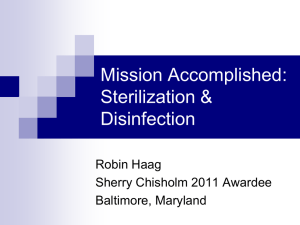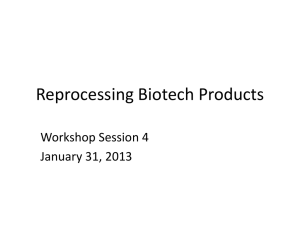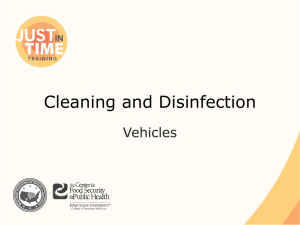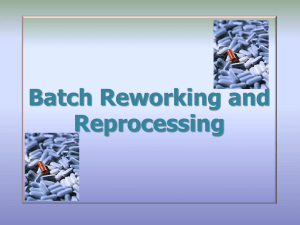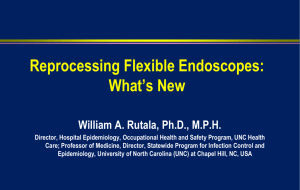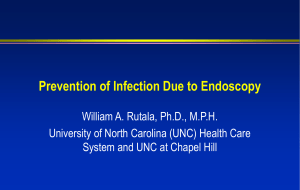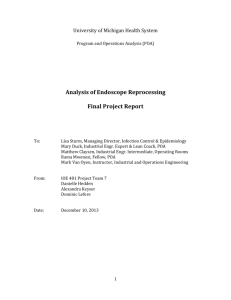PHO Powerpoint Template - title and standard slide
advertisement
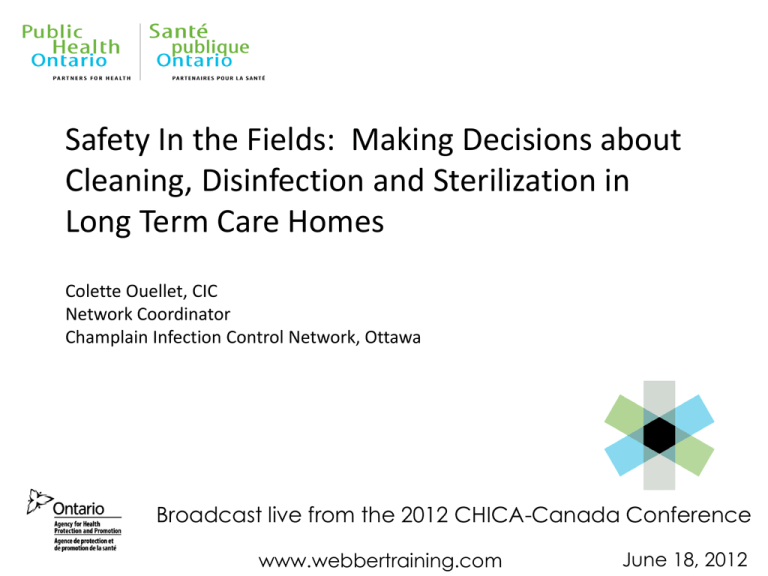
Safety In the Fields: Making Decisions about Cleaning, Disinfection and Sterilization in Long Term Care Homes Colette Ouellet, CIC Network Coordinator Champlain Infection Control Network, Ottawa Broadcast live from the 2012 CHICA-Canada Conference www.webbertraining.com June 18, 2012 Acknowledgements: • Karen Clinker Northwestern Ontario Infection Control Network • Angela MacAlpine, RN North East Mental Health Centre References: • PIDAC Best Practices for Cleaning, Disinfection and Sterilization in all Health Care Settings, February 2010 • CHICA Audit Toolkit • CSA Z314.8 Decontamination of Reusable Medical Devices, January 2001 • CDC Guideline for Disinfection and Sterilization in Healthcare Facilities, 2008 2 Objectives: • To review Spaulding’s criteria as a decision-making tool • To highlight the potential weaknesses of a Cleaning, Disinfection and Sterilization (CDS) program • To explore the parameters of a CDS audit 4 Spaulding Criteria • A clear and logical categorization of equipment based on risk to the patient/resident • Equipment is categorized as: • Noncritical • Semi-critical • Critical • Helps determine level of reprocessing required (i.e. low-level disinfection, high level disinfection, sterilization) 5 Noncritical Equipment • Touches only intact skin (but not mucous membranes) or does not directly touch the client/patient/resident • Divided into no-critical patient care items and noncritical environmental surfaces • Reprocessing involves cleaning followed by low level disinfection • In some cases, cleaning alone is acceptable Microsoft.com 6 Other examples of noncritical equipment • Oximeter • Glucose meter • Electronic thermometer • Hydrotherapy tank • Lift sling • ECG machine lead • IV pole, wheelchair, call bell Photo taken by Colette Ouellet • Bedpan, urinal, commode • Fingernail equipment that is single person use Semi-critical Equipment • Comes in contact with non-intact skin or mucous membranes, but does not penetrate them • Reprocessing involves cleaning followed by high-level disinfection (as a minimum) • Sterilization is preferred Microsoft.com 8 Other examples of Semi-critical equipment • Laryngoscopes • Respiratory Therapy equipment • Nebulizer cups • Ear syringe nozzle • Ear cleaning equipment, ear curettes, otoscope tips • Fingernail equipment used on multiple clients/residents Critical Equipment • Confer a high risk for infection if they are contaminated with any microorganism. • Enters sterile tissues, including the vascular system • Reprocessing involves cleaning followed by Sterilization • For Long Term Care, the most common equipment in this category are those used for foot care Microsoft.com 10 Other examples of Critical equipment • Dental equipment including high speed dental hand pieces • Neuro pin prick Microsoft.com 12 LOW LEVEL DISINFECTION INTERMEDIATE DISINFECTION NONCRITICAL • • Enveloped viruses Vegetative bacteria • Fungi HIGH LEVEL DISINFECTION STERILIZATION SEMI-CRITICAL CRITICAL • • Mycobacteria Non-enveloped viruses • • • Destruction of all forms of microbial life Bacteria with Spores Protozoa with cysts 13 • Disinfection is a two-step process • Items cannot be disinfected or sterilized until they are clean • Physical removal of organic and inorganic material is absolutely necessary in order for low level or high level disinfection, or sterilization to take place Microsoft.com Removal of gross soil ©istockphotos/incommunicado 15 Cleaning • Removal of soil, dust, foreign material • Involves soap and water, detergents or enzymatic cleaners • Detergents: Synthetic agents that can emulsify oils and suspend soil Contains surfactants that do not precipitate in hard water; may also contain protease enzymes and whitening agents Microsoft.com Cleaning • Completely submerge immersible items when possible • Cleaning may be manual or mechanical (e.g. ultrasonic washers) • Care for cleaning tools • Rinse following cleaning (residual detergent may neutralize the disinfectant) • Dry items Microsoft.com LOW LEVEL DISINFECTION INTERMEDIATE DISINFECTION NONCRITICAL • • Enveloped viruses Vegetative bacteria • Fungi HIGH LEVEL DISINFECTION STERILIZATION SEMI-CRITICAL CRITICAL • • Mycobacteria Non-enveloped viruses • Destruction of all forms of microbial life Bacteria with Spores Protozoa with cysts • • • • • • 60-95% alcohol Hypochlorite(1000ppm) 0.5% accelerated hydrogen peroxide QUATs (Quaternary ammonium compounds) • • • • • 6% Hydrogen peroxide 7% Accelerated hydrogen peroxide 0.2% Peracetic acid Gluteraldehyde OPH • • Steam Dry heat 18 Disinfectants should.…. • Be cost effective and have a long shelf life • Be safe and acceptable • Be compatible with surfaces • Be rapid in action against microbes and have a broad spectrum • Have little or no residue Disinfectants MUST.…. • Have a DIN (Drug Identification Number) from Health Canada Product Selection Source: CHICA Canada Audit Toolkit website 20 Low Level Disinfection Option Uses Good News Bad News Alcohols (60-95%) External surfaces of some equipment (e.g. stethoscopes) Non-toxic Low cost Rapid action Non staining • • • • • Chlorines Hydrotherapy tanks Low cost Rapid action Readily available • Corrosive to metals • Inactivated by organic material • Irritating to skin and mucous membranes • Use immediately once diluted • Use in well ventilated areas Blood spills 10 minutes of contact Evaporates quickly Flammable A poor cleaner Harmful to silicone, plastic • Inactivated by organic material 21 Low Level Disinfection Option Uses Good News Accelerated Hydrogen Peroxide (0.5%) Small hand contact surfaces • • • • • QUATS (Quaternary ammonium compounds) Floors, walls, furnishings Room surfaces Bad News Safe for the environment • Should not be Non toxic used on copper, Rapid action brass, carbonAvailable in a wipe tipped devices Active in the presence of and anodized organic material aluminum • Excellent cleaner • Non-corrosive, non-toxic, • Narrow microbial low irritant spectrum • Good cleaning ability; • Diluted solutions Blood spills prior usually has detergent may support to disinfection properties growth of • Rinsing not required microorganisms Not used to • May be disinfect neutralized by instruments various materials (e.g. gauze) 22 23 Sterilizing Reusable Medical Equipment • Critical medical equipment MUST be sterilized • Semi-critical equipment should be sterilized • Sterilize as per manufacturer’s instructions ©istockphotos/robertlevy Sterilization Indicators • Mechanical indicators are to be used to monitor sterilizer machinery • Chemical indicators are used for instruments undergoing sterilization • Both external and internal chemical indicators are used • All chemical indicators should be checked by staff members prior to utilizing the reprocessing equipment for care Photo taken by Colette Ouellet 25 Sterilization Assurance • Sterilizer tested with a biological indicator (BI) each day the sterilizer is used • Medical device should not be used until the BI is checked • A procedure must be established for the recall of improperly reprocessed medical equipment/devices Microsoft.com 26 Sterilizer Standards • Sterilizers must have a print out, maintenance and monitoring Microsoft.com Photo taken by Colette Ouellet 27 Event Related Shelf Life • The shelf life of a sterile package is event-related rather than time-related • Event-related shelf life is based on the concept that items that have been properly decontaminated, wrapped, sterilized, stored and handled will remain sterile indefinitely, unless the integrity of the package is compromised (i.e., open, wet, dirty) Microsoft.com 28 Storage Issues • Sterile items stored in their sterile packaging until time of use • Sterile items handled and stored in a manner to prevent contamination e.g. not stored on floor or near any moisture (sinks) • Storage area must meet specific requirements • • • • Separate sterile from dirty items No wooden shelves Free from vermin, dust, flies, not under or near ductwork or pipes No risk of tampering by anyone • No signs of compromise of packs 29 Reuse • This symbol does not means that an item can be used twice before being discarded. Microsoft.com 30 Photo taken by Colette Ouellet 31 Photo taken by Colette Ouellet 32 Your Reprocessing Area 33 Photos taken by Colette Ouellet 34 Your Reprocessing Area • Physical space is separated from where clean, disinfected or sterile devices are stored/handled, client care and procedure areas/rooms • All work surfaces are easily cleanable • There is a one way work flow • Portable fans are not used • Sink for cleaning medical devices is located near the work area 35 Your Reprocessing Area Source: CHICA Canada Audit Toolkit website 36 Pictures used with permission of Nancie Paquin 37 38 Get the most out of your audit…. During your audit there are 3 key areas to cover: 1.Review your policies and procedures 2.Conduct interviews with staff 3.Walk about Photo taken by Colette Ouellet 40 Reprocessing Risk Assessment Why Audit? •Familiarize yourself to what is really happening, not just what you think is happening -“walk abouts”- both formal and informal •Determine if Infection Prevention and Control standards and guidelines are being followed •Identify deficiencies, develop an action plan to address deficiencies, and implement the necessary changes •Ensure that the appropriate people are doing the job correctly •Reinforce Infection Prevention and Control Best Practices and Standards 41 42 Reprocessing Risk Assessment What’s Happening? Auditing for Reprocessing •Who? •What? •Where? •How? •Loaners? 43 Reprocessing Risk Assessment Document Review: •Accountability is defined for reprocessing practices and quality improvement activities? •Manufacturer’s guidelines are readily accessible and are being followed? •Policies and procedures posted/readily accessible? •Staff training parameters are met and training records are available? Reprocessing Risk Assessment Staff Interviews: •What equipment are you cleaning, disinfecting or sterilizing? •What is the decontamination process you are using to “clean” reused equipment in your area? •Do you have access to the manufacturer's written cleaning instructions/maintenance for this item? •What reprocessing training have you had? When did you last have it? Photo taken by Colette Ouellet Reprocessing Risk Assessment Observational Tours: •What equipment is being cleaned, disinfected or sterilized? •Is the proper workflow for reprocessing happening? •Are sterilized supplies being stored properly? •Is what staff say is happening really happening? •Are there reprocessing activities going on that you were unaware of? Photo taken by Colette Ouellet Photo taken by Colette Ouellet 47 Photo taken by Colette Ouellet 48 Photo taken by Colette Ouellet 49 Photo taken by Colette Ouellet 50 How Far to Take Your In-house Reprocessing? 10 Questions 1. Are all aspects of your reprocessing being supervised and carried out by knowledgeable, trained staff? 2. Has your decontamination area been approved by a reprocessing committee/those accountable, and does it conform to the requirements for a reprocessing area? 3. Have all your reprocessing policies and procedures had review by an individual with Infection Prevention and Control expertise? 4. Do you have written and available directions for the reprocessing of all reusable semi-critical and critical devices? 5. Does your sterilizer meet PIDAC and CSA standards and do you know how to use and maintain it properly? 51 6. Are any single-use critical and semi-critical medical equipment/devices being reprocessed? 7. Have cleaning/disinfection products used for any/all stages in reprocessing been approved by an individual(s) with reprocessing expertise? 8. Are all of your reprocessing staff immune to Hepatitis B or receive Hepatitis B immunization? 9. Are your reprocessed equipment/devices stored in a manner that minimizes contamination/damage? 10. Do you have a sterilization process that is validated, documented and audited? 52 In-House Reprocessing or Not? • Are there disposable/single use devices available to use instead of reprocessing reusable devices? • Is there a central reprocessing department in your area/region where a contract can be set up to reprocess the reusable devices for your setting? • If neither (a) or (b) are an option, and devices must be reprocessed at your setting, can you verify that recommendations for safe reprocessing are being met? In some instances, purchasing individual resident care items is the safest, most economical alternative Microsoft.com Summary • Know what’s happening in your practice setting through regular reprocessing audits • Take immediate action to address reprocessing deficiencies • Reprocessing is complex and carries high risk potential if not properly carried out 55 www.chica.org 11 July Control (Free WHO Teleclass … Europe) Patient Involvement in Infection – What Does it Mean and How Can We Support It? Speaker: Claire Kilpatrick, World Health Organisation Sponsored by WHO First Global Patient Safety Challenge – Clean Care is Safer Care 19 July 10 Must-Do’s for the Elimination of HospitalAssociated Infections (Free Teleclass) Top Speaker: Dr. William Jarvis, Jason and Jarvis Associates Teleclass sponsored by GOJO (www.gojo.com) 26 July (Free Teleclass) Pneumonia Prevention – The Vent and Beyond Speaker: Kathleen M. Vollman, Advancing Nursing LLC Teleclass sponsored by Sage Products Inc (www.sageproducts.com) 8 August (Free WHO Teleclass … Europe) Processing Medical Devices in Settings With Limited Resources Speaker: Dr. Nizam Damani, Craigavon Area Hospital, Northern Ireland
